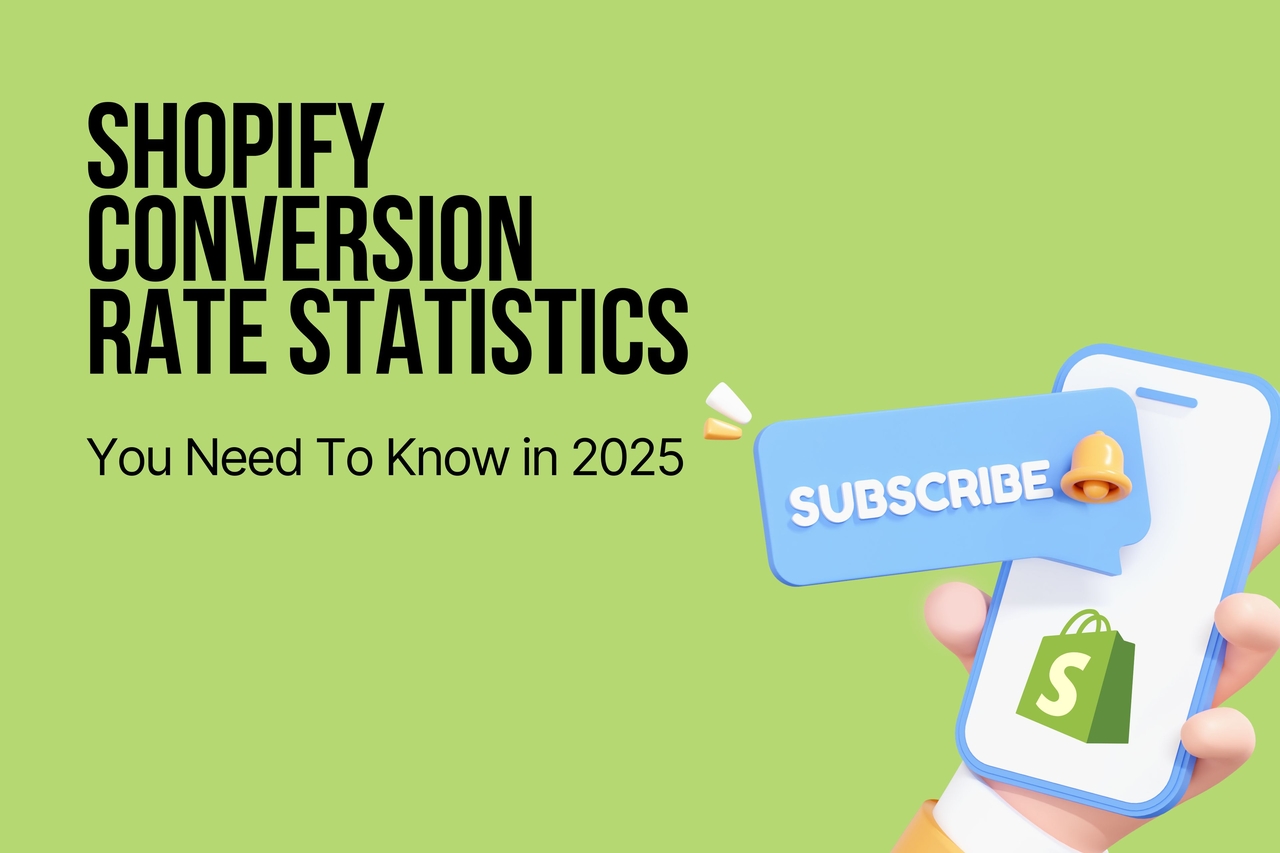About Shopify
Shopify’s story actually starts with something pretty relatable, trying to buy snowboard gear online. When the founders couldn’t find an e-commerce platform that felt right, they built their own. What began as a simple solution for a single store has now grown into one of the most influential e-commerce platforms in the world.
I’ve seen countless brands and small businesses scale on Shopify over the years, especially through the merchants we work with at Popupsmart. The platform lowers the barrier to entry so much that people can turn an idea into a fully running store in a single afternoon.
And the numbers behind Shopify in 2025 show just how big this ecosystem has become:
Based on the most recent industry data:
- There are approximately 6.3+ million live websites built with Shopify worldwide.
- The number of active Shopify stores is estimated at around 2.7 million+.
- Shopify merchants generated approximately $292 billion in GMV in 2024 alone.
On the financial side, Shopify continues its strong upward momentum:
- Total revenue reached approximately $8.88 billion in 2024.
- Subscription revenue makes up about 26–27% of overall revenue.
- Merchant Solutions, covering payments, checkout, and app ecosystem, remains Shopify’s largest and fastest-growing segment.
What’s unique is how brands of every size rely on Shopify. Global names like Whole Foods Market, Kylie Cosmetics, Budweiser, Pepsi, and even major publishers like The New York Times run their online operations on the platform. This wide adoption gives an interesting perspective on how powerful Shopify's infrastructure really is, especially when we start exploring conversion rates later in this guide.
One moment that perfectly captured Shopify’s role in the modern entrepreneurial landscape was a tweet by Harley Finkelstein, Shopify’s COO. He described Shopify as the engine behind the Great Reinvention, a shift that followed the Great Resignation, when thousands of people left traditional jobs to start something of their own.

I’ve personally seen this trend reflected in our own user base at Popupsmart. Many new merchants arrive with a simple passion, designing jewelry, roasting coffee, selling vintage finds, and they rely on Shopify’s tools to turn those ideas into real businesses.
Popups then become one of the first steps to help them capture leads and build momentum.
Considering all this, it’s easy to see why Shopify continues to be the platform of choice for new founders and established brands alike.
Its reach, growth, and merchant-first ecosystem make it a fascinating platform to analyze, especially when it comes to conversion rates. Let’s dive deeper into what the numbers tell us.
Shopify Conversion Rate Statistics (2025 Update)
Shopify continues to evolve into one of the most powerful e-commerce engines in the world, and conversion rate performance is a huge part of that story. To help merchants benchmark their stores effectively, here’s a fully updated 2025 breakdown supported by reliable industry sources.
📌 Key Shopify Conversion & Performance Stats (2025)
- Shopify processed approximately $292+ billion in GMV in 2024, showing steady growth across global markets.
- The average Shopify store conversion rate ranges between 1.4% and 1.8%, while top-tier stores exceed 3.2%.
- Shopify’s broader e-commerce benchmark places 2.5%–3% as a strong target range for healthy performance.
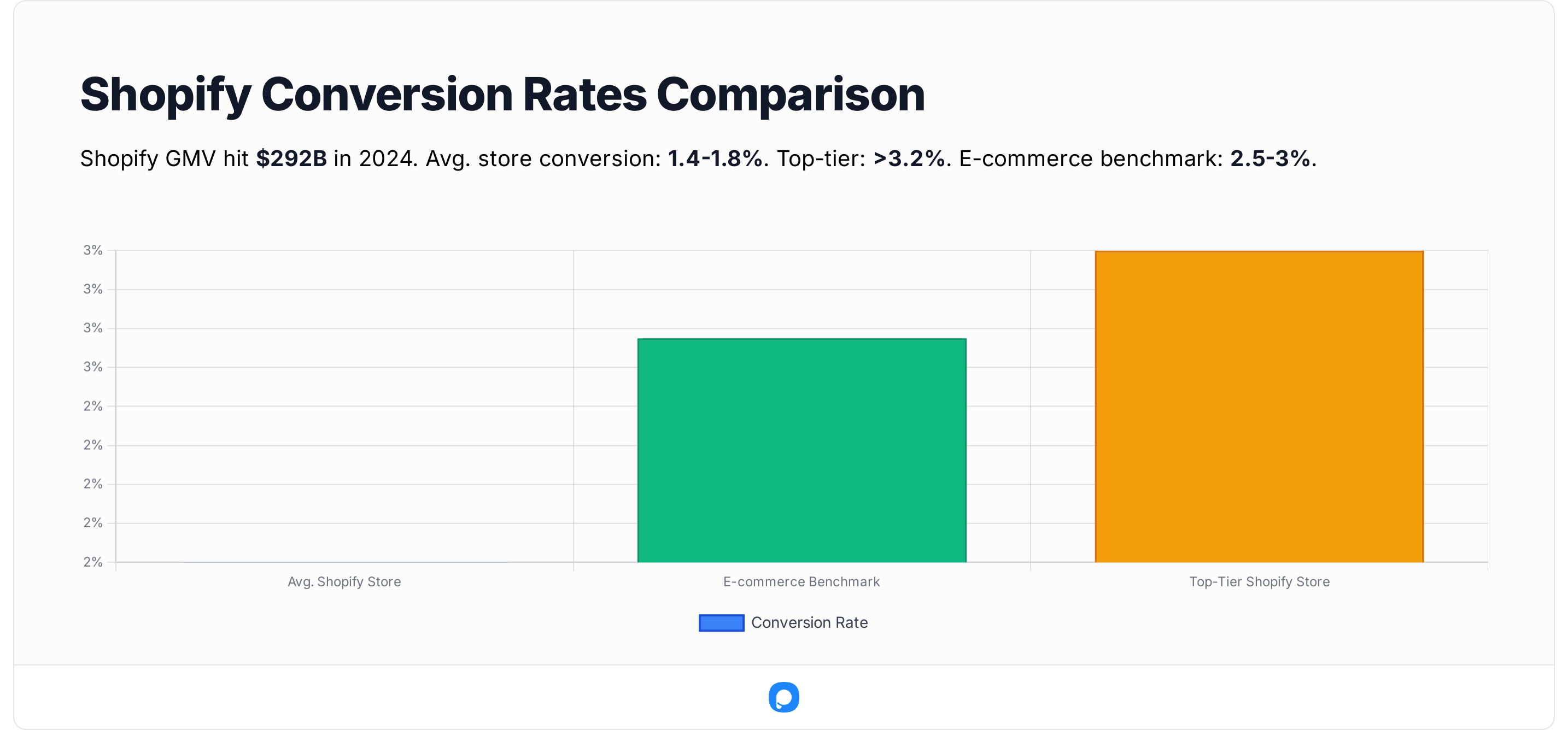
- Mobile vs. Desktop Conversion Rates:
- Mobile: ~1.2%
- Desktop: ~1.9%
- (Source: Uptek )
- Shop Pay significantly improves checkout completion rates due to one-tap flows and built-in trust signals.
- Shopify merchants hit $11.5 billion in BFCM sales , according to 2024 data,reaching record highs and highlighting strong buyer trust in Shopify stores.

Shopify Conversion Usage Statistics Over the Years.
(Source: Builtwith)
📋 Shopify vs. Industry Conversion Rate Benchmarks
⭐ Key Takeaways
- Shopify continues to outperform many platforms thanks to its optimized checkout, robust ecosystem, and high mobile usage.
- Stores achieving 3%+ conversion rates typically invest consistently in UX, speed, and CRO tools.
- There is still huge opportunity for underperforming stores, especially those not optimized for mobile.
- Shop Pay remains one of the strongest contributors to increased conversion rates.
- Seasonal peaks like BFCM show how powerful Shopify’s infrastructure is for handling large sales volumes.
💡 CRO Tips (Based on Shopify Merchant Performance)
Here are actionable insights Popupsmart frequently sees working across thousands of Shopify stores:
1. Use High-Intent Popups
Exit-intent offers, free-shipping bars, and discount reveals help reduce abandonment during key decision moments.
2. Prioritize Mobile Experience
With most traffic coming from mobile, focus on:
- Faster loading
- Thumb-friendly buttons
- Simple, short forms
- Clear product photos and reviews
3. Improve Checkout Clarity
Small tweaks, trust badges, shipping info upfront, and simplified forms, can dramatically increase completion rates.
4. Add Personalized Recommendations
AI-based or manual product suggestions boost AOV and funnel engagement.
5. Run Continuous A/B Tests
Test copy, popup timing, homepage hero sections, and CTA variations. Even a 0.2% improvement in conversion rate compounds significantly.
6. Optimize for Returning Visitors
Use targeted campaigns such as:
- Reminder popups
- Loyalty incentives
- Back-in-stock alerts
🚀 Shopify Conversion Data Every Store Owner Should See in 2025
What the latest numbers reveal, and what still matters today.
When I’m analyzing Shopify trends each year, I always notice the same pattern: the numbers shift, but the story stays surprisingly familiar.
Shoppers become faster, expectations get higher, and Shopify keeps pushing forward with one of the strongest e-commerce ecosystems in the world.
To understand where Shopify merchants stand today, it helps to look at a mix of fresh 2025 data and a few historical markers that shaped how the platform grew.
Here’s the story the numbers tell:
- Shopify reached a new peak with $292.28 billion in GMV, representing strong year-over-year acceleration and the highest GMV in Shopify’s history.
- In 2018's second quarter, Shopify received its billionth order. (Source: Shopify & You's statistics blog post)
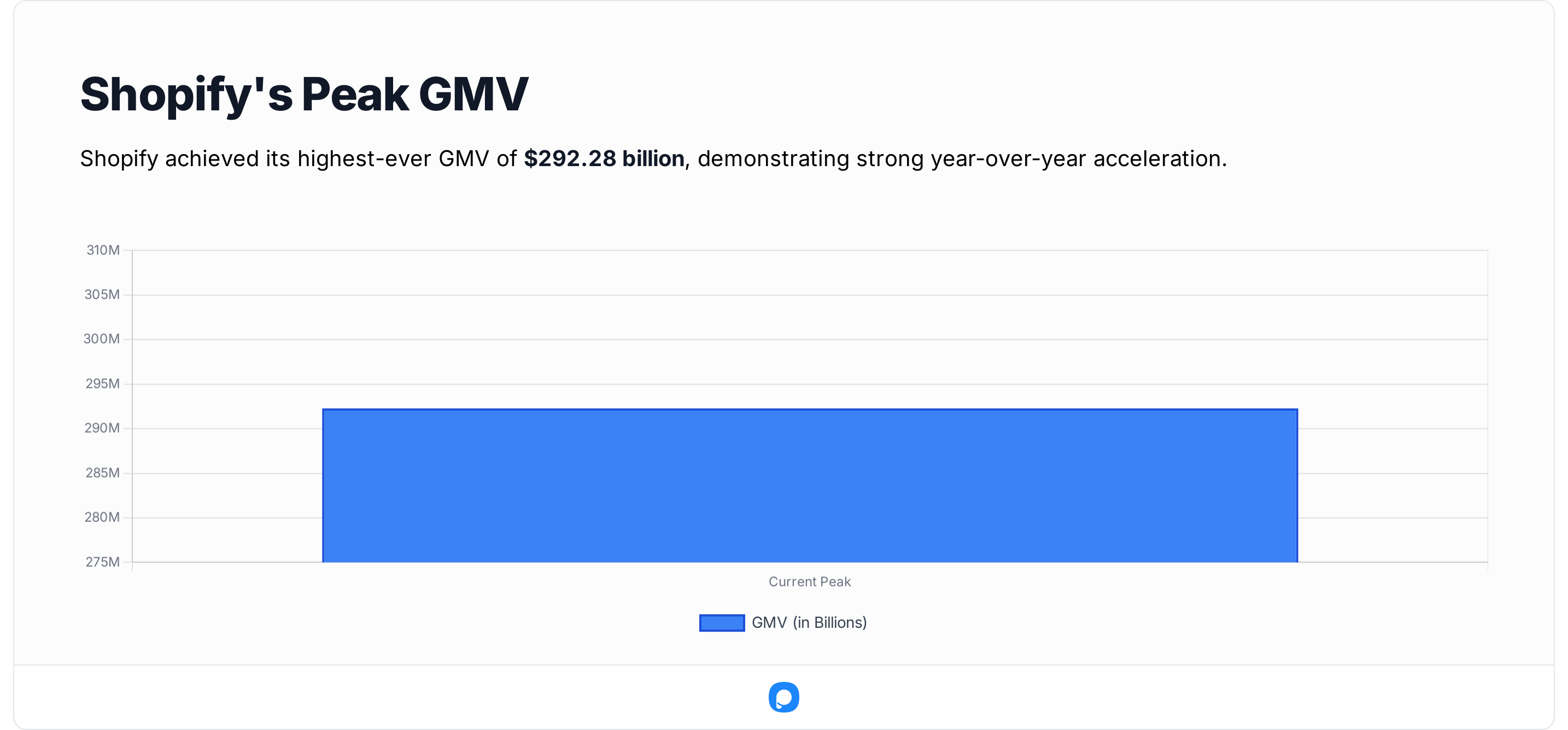
- Shopify’s total lifetime sales have grown far beyond earlier estimates; according to Shopify’s official reports, merchants have now generated over $1.1 trillion in cumulative global sales on the platform.
- In 2024, usage of Shop Pay surged by 58% year-over-year during the Black Friday–Cyber Monday weekend, according to Shopify.
- Shopify had a 19% increase in sales from the $6.3 billion during Shopify’s Black Friday Cyber Monday weekend in 2021. In 2022, that number rose to $7.5 billion, a 19% year-over-year increase.
- By 2024, Shopify merchants hit $11.5 billion in BFCM sales, setting a new record.
- According to Shopify’s 2025 benchmark, the average Shopify store converts around 1.4%, while stores converting at 4.7% or higher fall into the top-performing 10%.
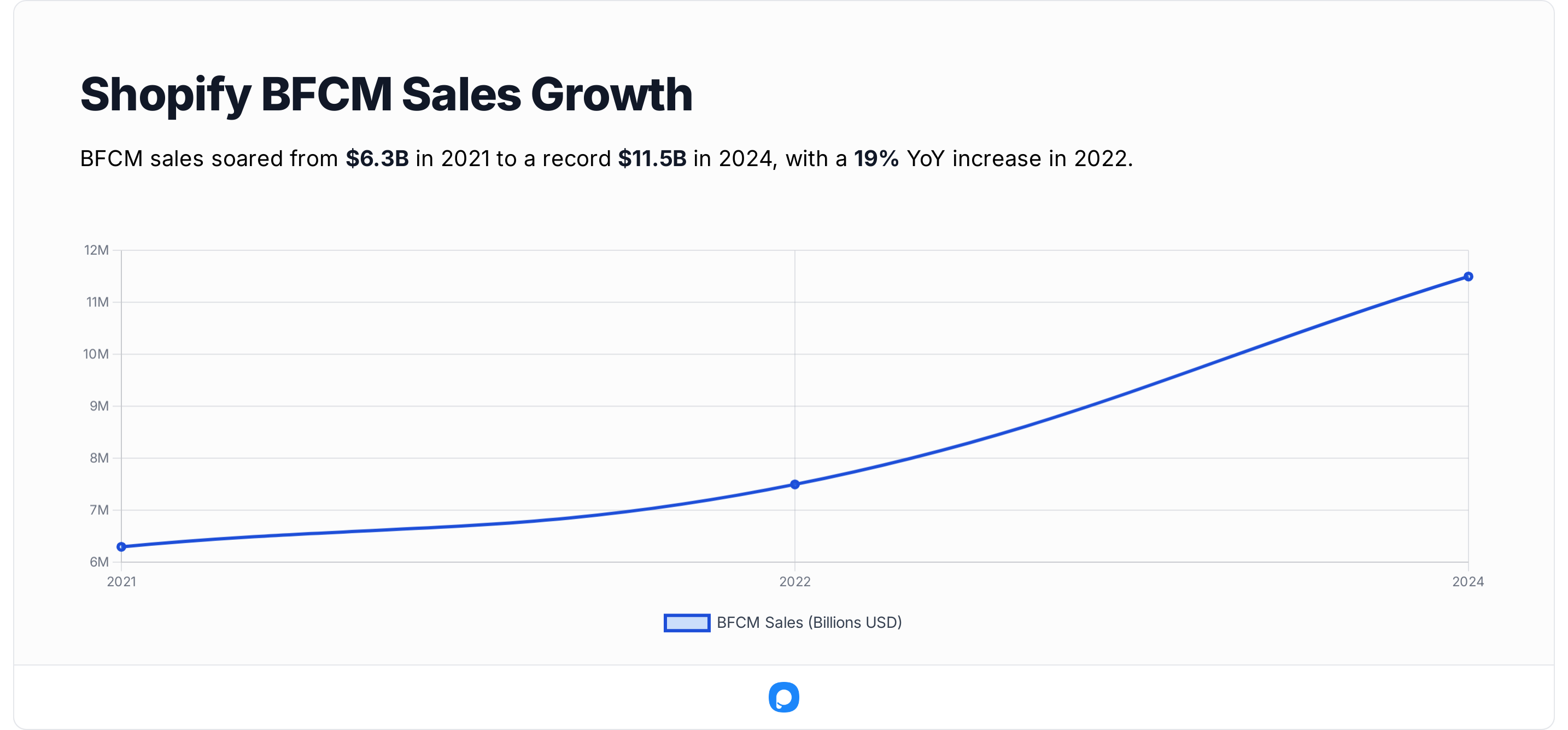
- Shopify doesn’t publish channel-specific conversion rates, but industry research consistently shows email as the highest-converting channel (≈3–5%), while social media converts notably lower.
- 81% of traffic and %71 of orders on Shopify stores were through mobile devices in 2019. Meaning that it increased from 77% and 67% according to 2018. (Source: Shopify & You's statistics post)
- More than 25% of Shopify’s recurring revenue is from Shopify Plus. Shopify Plus is used by famous brands such as Nestle, Kylie, Rebecca Minkoff.
- Shopify Plus contributed $41 million, or 29%, of MRR compared with 31% of MRR as of June 30, 2022. (Source: Shopify Second-Quarter 2023 Financial Results)
- In 2019, Shopify Plus users saw an average year-over-year growth of 126% alongside $1 million to $500 million annual revenues.
- Shopify Plus remains a core revenue driver; as of Q2 2024, it contributed 31% of Shopify’s MRR.
- On average, a US-based Shopify merchant earns a profit of $72 per customer, with high-earning merchants making $149 and low-earning ones making $44 per customer. (Synder)
- In 2022, Shopify generated increased 14% to $400.3 US dollars in subscription solutions and around $1.3 billion US dollars in merchant solutions. Both segments experienced rapid sales growth during the time period under consideration. (Source: Statista's research about total revenue segment of Shopify)
- It is stated that using 3D product images have a big impact on increasing conversion rates. As much as 250 percent conversion can be increased by using 3D images that show different sides of products.
📈 Average Conversion Rate on Shopify
To truly understand Shopify performance benchmarks, it’s helpful to know what “average” looks like, and then what “excellent” stores achieve.
- The typical Shopify store converts about 1.4% of visits into customers (2024-25 data from LittleData).
- If your conversion rate hits 3.2% or more, you’re among the top 20% of Shopify stores.
- Hitting around 4.7% or higher puts your store in the top 10% of Shopify performers.
- For mobile vs desktop: averages are about 1.2% on mobile and 1.9% on desktop for Shopify.
✅ Quick Takeaways:
- If your Shopify store converts below ~1%, there’s major upside potential.
- Between 1–3% is “average” territory, still viable, but room to optimize.
- Above ~3%? You’re outperforming most stores.
- Above ~4.7%? You’re in elite territory.
- Always remember: traffic quality, price point, product type, device mix and checkout experience all influence these numbers.
💸 Shopify Conversion Rate Statistics by Industry
One of the things I love about Shopify is how many different kinds of businesses call it home, from handmade jewelry shops to SaaS companies, boutique fashion brands, home-goods stores, local service providers, and everything in between. Each industry has its own rhythm, its own customer behavior, and naturally… its own conversion rate benchmarks.
To help you see where your store really stands, we pulled together the latest Shopify conversion rate statistics across major industries.
These benchmarks make it easier to compare performance, spot opportunities, and understand what “good” looks like in your niche.
Let me break it down.
Shopify Fashion Industry Conversion Rate Statistics
- Apparel and fashion brands make up 13% of Shopify Plus. (Source: Enlyft's research about Shopify companies)
- Around the world, the most sold products on Shopify are t-shirts and tops, according to 2019’s data.👚🛍
- Though they hardly make the top-50 in other countries, dance dresses and costumes are the most sold products in Germany.💃🏻 (Source: Konstruct Digital's Shopify statistics research in 2020)
- As a Shopify designer handbag company, Rebecca Minkoff has a 9% conversion rate with a 14% average order value. (Source: Tangiblee's case study about Rebecca Minkoff)
- According to a 2025 report, fashion ecommerce conversion rates are projected to range between 2.9% and 3.3% (with women’s clothing averaging ~3.6%) across the broader apparel market.
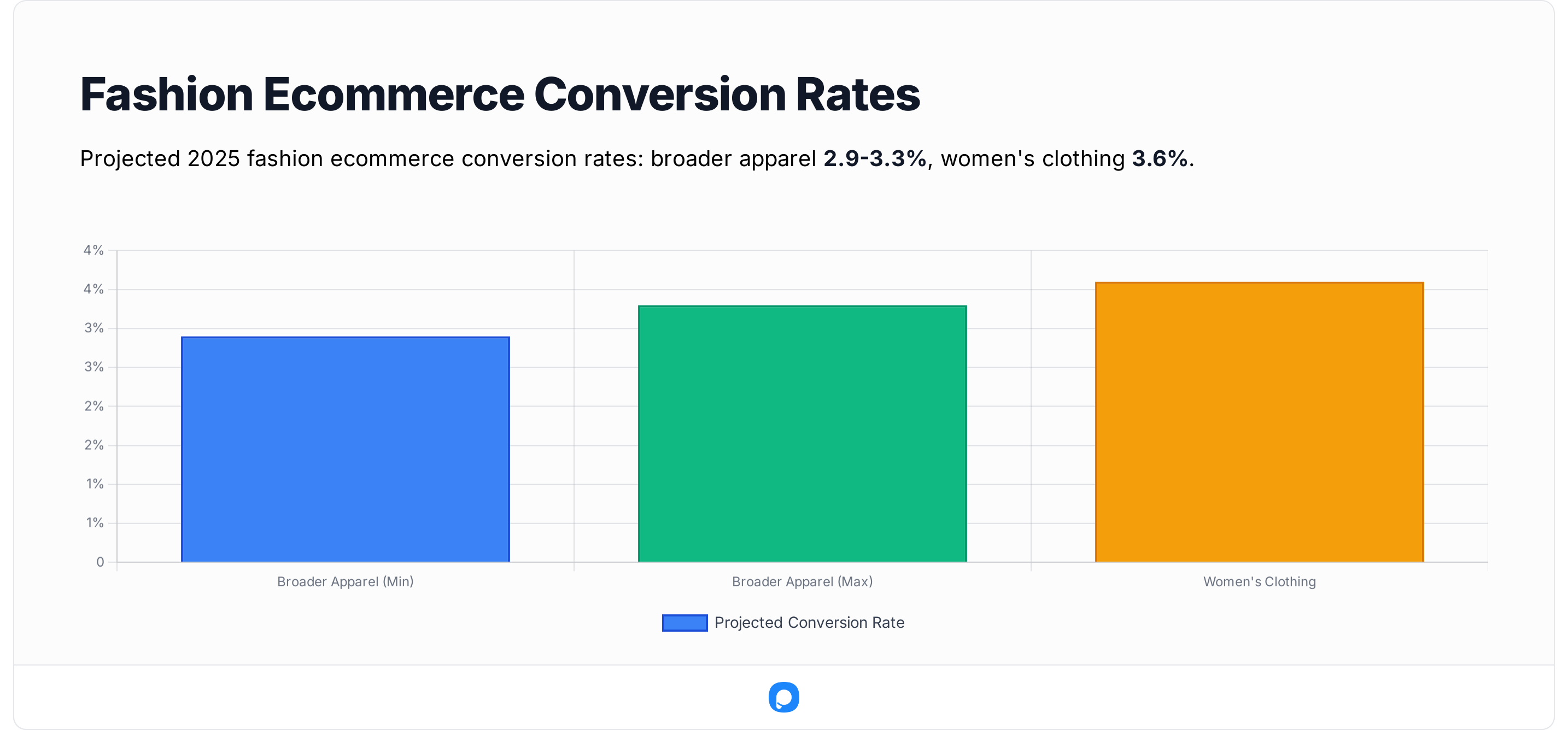
- For Shopify specifically, a 2025 benchmark tool reports the fashion/retail category converting at around 1.6%–1.9% on Shopify stores.
- A 2025 industry insight via Shopify’s own blog states that the global fashion-ecommerce market (apparel & accessories) hit a valuation of $770.9 billion in 2024, indicating scale and scope for this niche.
💄 Shopify Beauty & Cosmetics Industry Conversion Rate Statistics (Updated for 2025)
- Colour Pop is a Shopify cosmetics brand that is ranked in 40th place in Beauty and Cosmetics category. It has ~1.8 M visits and 38.71% bounce rate. (Source: SimilarWeb's overview page of Colour Pop)
- One of the most famous Shopify brands, Kylie Jenner’s Kylie Cosmetics, sold out its first 15,000 lip kits in minutes in 2015.🤯 (Source: Forbes profile of Kylie Jenner)

- Kylie Jenner’s famous brand is a Shopify brand with ~741.3 K visits and 45.4% bounce rate. It also ranks in 159th place in the Beauty and Cosmetics category. (Source: SimilarWeb's overiew of Kylie Cosmetics)
- Elf Cosmetics is ranked at 33rd place. Also, this famous cosmetics brand has ~2.7 M visits and 52.34% bounce rate. (Source: SimilarWeb's overview of Elf Cosmetics)
📊 Shopify Conversion Trends for 2025
If there’s one thing I’ve learned analyzing high-performing Shopify stores, it’s this: conversion behavior shifts faster than most brands expect. What worked in 2023 already feels old. And in 2025, customers don’t just want a smooth experience, they expect it.
Here are the trends I’m seeing shape Shopify conversion rates this year. These aren’t theories. They’re patterns that keep showing up across real Shopify stores we work with and study.
🎢 Best Shopify Themes for Driving Higher Conversions
The theme you use on your Shopify store can significantly impact your conversion rate. That’s why we’ve compiled a list of the highest-converting Shopify themes you can use on your website.
1. Empire

Empire is one of the highest-converting Shopify themes thanks to its catalog-focused layout.
It’s designed to showcase high-quality visuals and large product ranges, making it ideal for categories such as electronics, home & garden, and industrial equipment.
Pricing: Comes with a free trial, then available for $300.
2. Warehouse

Warehouse is one of the best theme options for showcasing large product catalogs.
It’s typically preferred by stores selling electronics, sporting goods, and home & garden products.
Pricing: Free trial available; purchase price is $300.
3. Impulse

With its customizable and flexible design, Impulse is one of the best theme options for fashion and accessories.
It’s also commonly used in the health and beauty category. Impulse is ideal for visual storytelling and helps highlight your products in a way that can boost conversions.
Pricing: Free trial available; purchase price is $320.
FAQs
1. What is considered a good conversion rate on Shopify?
A conversion rate above 3.7% is generally considered strong and places your store in the top 20% of Shopify merchants. Stores converting above 5.2% are typically in the top-performing 10%.
2. Which Shopify theme delivers the highest conversion rates?
There’s no single best theme for everyone, it depends on your niche and target audience. However, some of the most consistently high-performing conversion-focused themes include:
- Empire
- Warehouse
- Impulse
Other popular and well-converting options are Retina, Minimal, Fashionopolism, and Debutify.
3. Do themes really impact Shopify conversion rates?
Yes. The theme you use affects:
- How products are displayed
- Site navigation & catalog layout
- Page load speed
- Mobile UX and checkout clarity
All of these directly influence conversion performance.
4. Should I choose a theme based solely on conversion performance?
Not always. While conversion optimization is critical, your theme should also match:
- Your brand identity
- Product type
- Catalog structure
- Content strategy
Ideally, choose a theme that balances aesthetics, performance, and scalability.
That’s the story of Shopify conversions in 2025, expectations are higher, but even small tweaks can create big wins. A smoother checkout, a better-timed popup, or clearer messaging can move the needle more than you might expect.
So, what’s the first improvement you’re thinking of testing?
Check out these blog posts, as well:
